Under my vine
- colinfell6

- Aug 19, 2021
- 5 min read

One unknowable and undated day in about 1860, someone stood amidst the bloody abbatoirs of Penzance’s Bread Street, surveyed the rough fields to its North, stretching towards the estate of Treneer Manor, and concluded that, with land and labour both being cheap, there was money to be made from housing. Over the next few years Alma Terrace emerged, speculatively stretching towards Taroveor Road. Its name was a nice bit of Victorian triumphalism, celebrating what the empire had decided was a successful bit of fighting in the Crimea (casualties estimated at 530000; outcome the weakening of Russian influence in Europe).
Iron gates at either end emphasised that the terrace was of, and yet apart from, the town. The plot available for building was circumscribed by the charmingly named Perkins’ footpath, connecting the fields of Treneer with the town centre, and whilst the identity of the eponymous Perkins has, like so much, evanesced, faded beyond our understanding, it is preserved in finely chiselled letters on the corner house. Between a worked-out quarry and Perkins’ footpath- I imagine a bucolic, ruddy cheeked Cornish landowner, swinging his stick as he wandered through on his way to the market, bank, or harbour- there was a wedge-shaped space to squeeze in some gardens, short at the top end of the terrace and lengthening towards the south.
And, exactly a quarter of a century ago, in the far away, pre-internet, pre-covid world off the 20th century, in buying my house, I also became the owner of one of these odd little gardens, carved out of Cornish heathland. Well, the estate agent described it as a garden; “laid to lawn”, was the memorable phrase, a fine example of the semantic disingenuousness of those who make a living from property. The word lawn invariably evokes in my mind the image of a smoothly emerald greensward, possibly scalloped into interesting curves, over which a mower, hand propelled, is slowly and lovingly driven; there might be a jug of lemonade sitting on a garden table, and sparrows chattering in a weeping willow. It is of course possible that the agent was using the word in its 14th C Middle English sense, a “laun” designating a glade between areas of forest; or even the old French “lande”, meaning simply a heath, or barren land- a more accurate description of this hundred-foot slice of nature in the raw. At the top end was a straggly sycamore, and an escallonia bush, obligingly flaunting its pink flowers when I bought the house, whilst in the far corner was a dolmen of granite stones, surmounted by an ancient cast iron bath, a surreal Noah’s Ark perched on a stony Mount Ararat, surrounded by seas of long flowering grasses.
As the proud possessor of a new baby, and as someone who had read far too much Wordsworth and Coleridge, I was possessed with visions of his infancy softened and enriched by summer months of splendour in the grass. But in that faraway summer this ideal seemed elusive- how to turn this waste land into a garden where his infancy might unroll amidst butterfly bedecked bushes and bee visited flowers?
Like a friendly emissary from the underworld, a friend turned up with a flame thrower, advancing colonially through the undergrowth, slashing and burning as he went, and then rotavating, churning the remains back into the rich earth. There is, or was, somewhere, a photograph of this long and slightly tapering rectangle of brown, newly ploughed Cornish earth, bordered on one side by a tigerish larch lap fence, and on the other by an immense and aged privet. I can see it clearly, and even dreamed of it recently, this shot of the garden’s unimaginable zero summer; but it has disappeared.
Confronted with this tabula rasa, my early attempts at planting were largely efforts to recapture what I liked about my own childhood garden- so there had to be daffodils to herald the arrival of spring, an Amelanchier, for its blossom and coppery leaves, a philadelphus, to fill summer evenings with its heady fragrance of orange blossom, roses to fill the rain-freshened air with myrrh, honeysuckle with its heart stopping scent, and fruit trees whose produce would cheer September’s darkening evenings. I sentimentally planted a “family” pear tree, its three varieties grafted onto one rootstock with a symbolism which was highly pleasing to a couple with a baby. I even recall dreaming at one fevered moment that I was interviewing plants for a place in the garden, the peony performing particularly unimpressively, and to this day absent from the plot. If my gardening had a principle, it was that of abundance, loading every rift with ore, with colourful but chaotic results; I called in a gardening friend one year, who gazed and sighed, as Capability Brown might have, surveying some decayed Georgian estate, and remarked that I had to decide whether I wanted “a garden or a collection of plants”. He produced speculative plans of neat symmetrical borders, all of which I ignored.
May and June are when the garden is at its best; there’s a rewarding sequence of blossoms, from the startling stars of the Snowy Mespilus to the more modest effusions of the pear tree, and then the pinkness of the apples. And the roses are in their first flush, throwing out buds with all the careless fecundity of the spring. By July and August, the cautionary words of my gardener friend return to haunt me- sulking between flowerings, the roses are cowed by their more assertive neighbours, the bullying Charles Druce geranium, the invasive Japanese anemones, the banks of wallflowers, the sweet peas I’ve unwisely squeezed in, and the vaguely prehistoric towering echiums. The fruit trees I neglected to prune have flung their long unproductive branches into the air, and the grapevine luxuriantly crushes its fence. And that’s without mentioning the things which really want to grow here, because they always have, for hundreds of years, and don’t see why they should change their ways for some here- today, gone-tomorrow, part-time gardener like me; the forget me nots, the wild garlic, the ragged robin, the loosestrife, the valerian, the wood avens and of course the serpentine curls of bindweed and ivy.
By August, the apples are clustering promisingly, the grapes are hanging in unripened clusters, and the roses blithely nodding as though summer and its warm days will never cease. Yet cease they will, and as the evenings darken, the colours will sink back into the increasingly hydroptic earth, their brief pageant faded, and the long thin plot I call my own will slumber, as it has for centuries; for this is heathland, belonging to no-one; and whatever I do to it, the seeds which have lain in it for centuries, will re-emerge, undaunted and vigorous, indomitable. And herien lies, in the end, its real, most lasting charm.


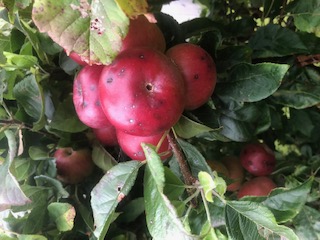

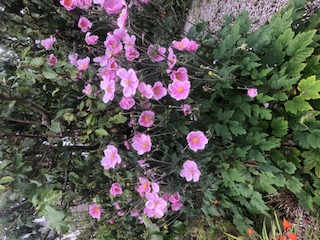

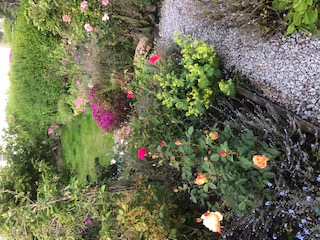



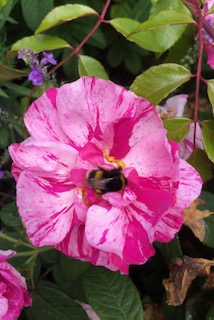

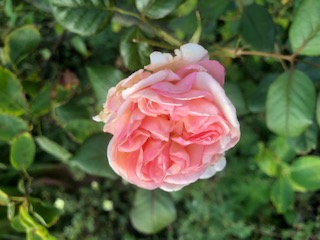

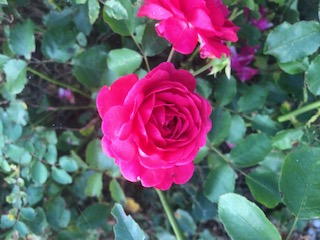

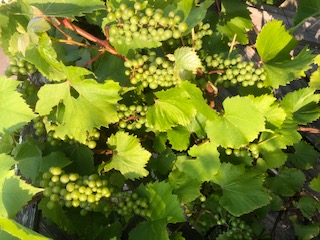

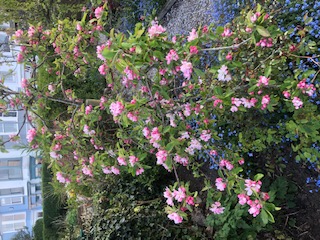



Walked along Alma Terrace today as it is my favourite road in Penzance, the view across the gardens to St Michaels mount is beautiful. However I saw the 'Perkins foot path' sign and went down a rabbit hole trying to find information. Thank you for sharing.